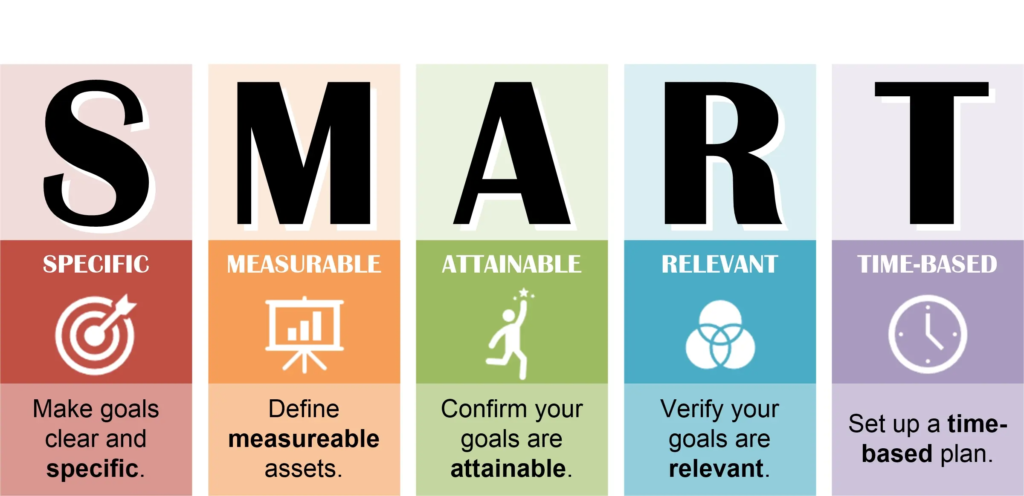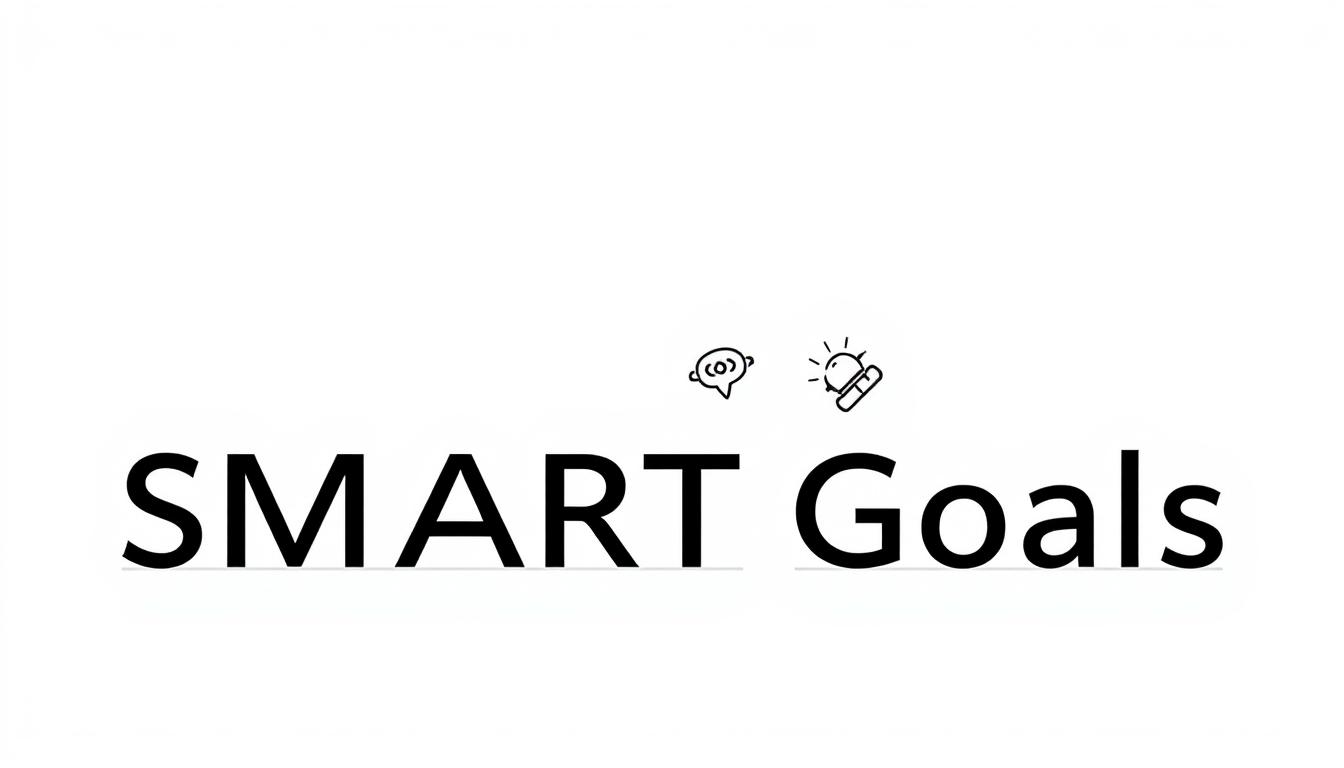“What gets measured gets improved” – Peter Drucker’s timeless words capture why clear objectives matter. Without them, even the most driven teams and individuals risk stagnation. Take Jane, a project manager whose team struggled with vague targets like “improve outreach.” It wasn’t until she adopted the SMART framework – crafting Specific, Measurable, Achievable, Relevant, and Time-Bound goals – that her team transformed ambiguity into action.
Many people stumble because their aspirations lack structure. For instance, “launch a mobile app” becomes impactful only when refined to: “Achieve 50,000 installs by June 30 with a 5% conversion rate.” This shift from fuzzy ideas to precise milestones turns effort into progress.
The SMART method isn’t just for corporate teams. Whether advancing your career or personal growth, defining clear steps aligned with your values ensures every task matters. This article will show how to break down abstract dreams into achievable actions – like reducing time spent on repetitive tasks by 15% or mastering new skills within three months.
Key Takeaways
- Clarity in objectives prevents wasted effort and keeps focus on meaningful results.
- The SMART framework creates accountability through measurable, time-sensitive targets.
- Real-world examples – like app launches or skill-building timelines – demonstrate the power of structured planning.
- Aligning goals with broader priorities ensures relevance and long-term success.
- Breaking ambitions into smaller steps builds momentum and makes progress visible.
Understanding Specific Goal Setting
Clear objectives act like GPS coordinates for personal and professional growth – they eliminate guesswork and create actionable paths. Unlike vague wishes, structured targets answer critical questions: Who is involved? What needs accomplishment? When must it be completed? This precision transforms abstract ideas into achievable steps.

What Is Specific Goal Setting?
It’s the practice of defining outcomes with measurable details and deadlines. For instance, “improve fitness” becomes impactful when reshaped as: “Complete three 45-minute strength sessions weekly at home gym by December 15.” This approach, rooted in the 5 W’s framework, clarifies responsibilities and timelines – key factors in achieving meaningful outcomes.
The Importance of Clear Objectives
Ambiguity breeds hesitation. When teams or individuals lack direction, efforts scatter. Consider a sales team aiming to “increase revenue” versus targeting “15% growth through 50 new client onboardings by Q3.” The latter aligns daily tasks with broader priorities, fostering accountability. Research shows people who define precise milestones are 42% more likely to follow through, as specificity activates commitment mechanisms in the brain.
Well-crafted objectives also simplify progress tracking. Saving $5,000 annually breaks into $96 weekly deposits – a tangible step making large ambitions manageable. This method works across life domains, from career advancements to skill development, ensuring every action contributes to measurable growth.
Benefits of SMART Goals for Achieving Objectives
Imagine building a house without blueprints – materials scatter, timelines blur, and results disappoint. SMART objectives act as architectural plans for success, turning chaotic efforts into structured achievements. This framework’s real power lies in its ability to create visible pathways where progress becomes tangible and momentum builds naturally.

Measurable Outcomes and Progress Tracking
SMART criteria transform abstract ideas into numbered checkpoints. A fitness enthusiast aiming to “get healthier” gains clarity by targeting “Lose 12 pounds in 90 days through 4 weekly gym sessions.” Quantifiable milestones like these enable weekly weigh-ins and workout logs – creating a feedback loop that highlights what’s working.
| Vague Objective | SMART Version | Tracking Method |
|---|---|---|
| Improve sales | Increase Q4 revenue by 18% via 25 new contracts | Weekly client outreach reports |
| Learn coding | Complete Python basics course in 6 weeks | Module completion dashboard |
Enhanced Focus and Increased Motivation
Clear parameters eliminate distractions. When a marketing team shifts from “boost engagement” to “achieve 500 newsletter sign-ups monthly,” every campaign aligns with that target. Research reveals people using measurable benchmarks are 3x more likely to persist through challenges.
Seeing incremental wins fuels determination. A writer completing 1,200 words daily toward a book deadline doesn’t just track pages – they witness their vision materializing. This visibility turns effort into excitement, proving that “what gets measured gets celebrated” along the journey.
Mastering Specific goal setting for Success
Transforming aspirations into achievements requires more than vision—it demands precision. Jane’s experience shows how refining objectives using the SMART framework bridges intention and results. After revising her team’s vague targets, she aligned tasks with their capabilities, ensuring resources matched priorities.

Practical Techniques for Daily Implementation
Break each SMART element into bite-sized actions. For Specific, ask: “What three steps will move this forward today?” Measurable progress thrives on tools like time-tracking apps or weekly checklists. A sales team aiming for 200 new clients quarterly might set daily outreach quotas.
| SMART Element | Jane’s Implementation | Daily Routine |
|---|---|---|
| Achievable | Assessed team bandwidth before setting deadlines | 15-minute capacity reviews every Monday |
| Time-Bound | Used project management software with milestones | Automated progress alerts every Friday |
Industry leaders like Microsoft’s Satya Nadella emphasize “aligning goals with existing systems.” This means evaluating whether targets fit your team’s skills and tools. A study by Asana found teams using SMART criteria complete projects 27% faster.
Regular audits prevent drift. Ask: “Does this objective still match our quarterly priorities?” Adjust timelines if market shifts occur. Tools like Trello or Notion help visualize progress while maintaining flexibility—key for sustained success in fast-paced environments.
Steps to Create Actionable Goals Using the SMART Framework
Turning ideas into results starts with structure. The SMART method bridges the gap between ambition and execution by breaking aspirations into manageable steps. Let’s explore how to design targets that deliver real-world impact.
Defining Objectives and Responsibilities
Clarity begins with answering two questions: What exactly must happen? and Who owns each task? For example, Techfirm transformed “grow app users” into “Increase monthly users by 1,000 through optimized app-store listings and targeted Facebook/Twitter campaigns by March 31.” This pins down deliverables while assigning roles to marketing and development teams.
Building Trackable Milestones
Numbers create accountability. Instead of “improve customer service,” a measurable version might state: “Achieve 90% satisfaction ratings via 24-hour response times by Q2.” Pair metrics with deadlines to maintain urgency.
| Ambiguous Target | SMART Version | Tracking Tool |
|---|---|---|
| Boost social media | Gain 500 followers/month on Instagram | Analytics dashboard |
| Learn new skills | Complete UX design course in 8 weeks | Weekly quiz scores |
Aligning With Real-World Capacity
Ambition needs grounding. When Jane’s team lacked bandwidth for four platforms, they focused on three – maintaining quality without burnout. As Microsoft’s Satya Nadella notes: “Aligning goals with existing systems prevents overextension.”
Finally, connect each milestone to broader priorities. Growing app users matters most when tied to customer retention or career advancement. Regular check-ins ensure plans stay relevant as circumstances evolve.
Overcoming Common Obstacles in Goal Setting
Even well-crafted plans hit snags—the real test lies in navigating them effectively. Unclear benchmarks and shifting priorities derail progress faster than poor planning. A McKinsey study found 68% of teams struggle with misaligned objectives, wasting 22% of work hours on non-essential tasks.
Identifying Roadblocks and Adjusting Strategies
Common pitfalls emerge when action steps don’t match capabilities. For example, a startup aiming to “dominate social media” stalled until they redefined success as “gain 10,000 engaged followers across two platforms in six months.” This pivot allowed realistic resource allocation.
| Obstacle | Adjustment Strategy | Outcome |
|---|---|---|
| Procrastination | Break tasks into 20-minute daily actions | 45% faster project completion |
| Fear of failure | Weekly progress reviews with peers | 38% higher team motivation |
Timely intervention matters. When a software team missed coding milestones, they shifted from weekly to daily check-ins—reducing errors by 60%. As productivity expert James Clear notes: “Adaptation isn’t plan B; it’s part of the process.”
Regular feedback loops prevent small issues from becoming crises. A fitness coach might adjust workout plans monthly based on client energy levels and performance data. This flexibility ensures goals stay aligned with evolving values and capacities.
Integrating Systems for Continuous Improvement
Habits shape outcomes more than isolated achievements. James Clear’s Atomic Habits reveals a truth many overlook: “You don’t rise to the level of your goals – you fall to the level of your systems.” This systems-first mentality prioritizes repeatable processes over temporary targets, creating lasting momentum.
Systems Versus Goals: A Balanced Approach
Goals define endpoints – systems fuel the journey. A sales team hitting quarterly targets might celebrate, but without standardized client onboarding routines, future growth stalls. Research shows organizations using continuous improvement systems sustain 34% higher productivity long-term compared to goal-focused peers.
| Goal-Focused Approach | System-Focused Approach | Long-Term Impact |
|---|---|---|
| “Increase revenue by 20%” | Weekly client feedback reviews | Consistent 5% quarterly growth |
| “Lose 15 pounds” | Daily 30-minute walk routine | Maintained weight for 3+ years |
Developing Consistent Routines and Feedback Loops
Effective systems thrive on measurable rhythms. A software company reduced bugs by 40% after implementing Friday code reviews – a simple routine creating immediate quality checks. As system-oriented strategies show, progress compounds when daily actions align with core values.
Three steps to build improvement systems:
- Map recurring tasks that drive 80% of results
- Create visual trackers (apps/whiteboards) for habit consistency
- Review metrics biweekly to spot patterns
Teams using PDCA (Plan-Do-Check-Act) cycles adapt 50% faster to market shifts. Whether refining personal habits or organizational workflows, systems turn effort into enduring excellence.
Conclusion
Research shows people with structured plans are 42% more likely to hit milestones than those relying on vague intentions. The SMART framework bridges this gap, turning aspirations like career growth or financial stability into measurable steps. Whether aiming for six-figure incomes or skill mastery, breaking ambitions into weekly actions creates momentum – just as studies reveal detailed planners achieve 27% faster results.
Success thrives on systems, not just endpoints. Tools like progress dashboards or biweekly reviews – inspired by PDCA cycles – help maintain alignment with core values and evolving priorities. Teams using feedback loops adapt 50% quicker to challenges, proving continuous improvement drives lasting performance.
Your journey starts now. Revisit the actionable strategies here: define trackable metrics, build routines, and celebrate small wins. As data confirms, those who refine their approach quarterly see 34% higher success rates long-term. Transform your objectives into a roadmap – clarity today fuels tomorrow’s achievements.
FAQ
How does specific goal setting differ from general aspirations?
Specific goal setting requires defining clear, actionable steps with measurable outcomes—unlike vague aspirations. It uses frameworks like SMART criteria to create structured plans with deadlines, responsibilities, and progress checks. This method transforms abstract ideas into achievable tasks.
Why are SMART goals considered more effective for tracking progress?
SMART goals—Specific, Measurable, Achievable, Relevant, Time-bound—provide built-in metrics for assessing advancement. They eliminate ambiguity by breaking objectives into quantifiable milestones, making it easier to identify delays, celebrate wins, and adjust strategies as needed.
Can you break down large career goals using specific goal-setting techniques?
Yes. Start by dividing long-term career objectives into short-term, actionable steps. Assign deadlines, identify required skills or resources, and establish checkpoints for feedback. For example, “Complete a leadership certification in 6 months” becomes a milestone toward a larger promotion goal.
How do you handle setbacks when working toward specific objectives?
Anticipate potential roadblocks during planning—like time constraints or skill gaps—and create contingency strategies. Regularly review progress using tools like weekly check-ins or performance dashboards. Adjust timelines or methods while keeping the end objective in focus to maintain momentum.
What role do systems play in achieving goals compared to goal setting alone?
Systems—like daily routines or feedback loops—support consistent action beyond initial planning. While goals define the destination, systems ensure reliable progress through habits and accountability. For instance, a writer aiming to finish a book might pair a “write 500 words daily” system with their publication timeline.
How can teams ensure alignment when setting shared objectives?
Use collaborative tools like RACI matrices (Responsible, Accountable, Consulted, Informed) to clarify roles. Hold alignment workshops to connect individual tasks to broader team targets. Regular progress updates and transparent communication prevent misaligned efforts.




























































